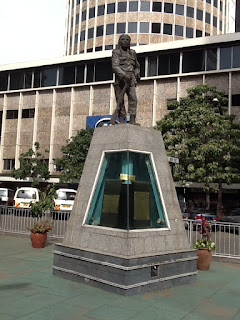The statue of Field Marshal Dedan Kimathi on Kimathi Street in Nairobi.
Kimathi was captured and hanged by the colonial government at the height of Kenya’s freedom struggle. His grave at the Kamiti Prison has never been identified.
A sculpture is a three-dimensional object with a message. It could be a statue thriving in the context of a city like Nairobi, watching over people coursing through a life that is damn so daily.
Sculptures have a life of their own since within every block of wood, iron, or stone lies a spirit waiting to be carved.
Nairobi’s latest is the statue of nationalist Tom Mboya on Moi Avenue. It was unveiled by President Mwai Kibaki on the eve of Mashujaa Day this October as a tribute to Mboya’s “remarkable contributions” to this country, and to “honour the departed hero and remind the nation of whom he was” and “what he stood for”.
Tom Mboya’s is the second statue to be gazetted as a national treasure, after that of freedom fighter Dedan Kimathi in 2007.
That was the year the government created a task force to carry out countrywide data collection to establish criteria for identifying, recognising, and honouring national heroes and heroines.
Mr Gideon Siundu, a lecturer at Masinde Muliro University, wrote in a local newspaper then that such monuments “act as public sites of memory, complementing in useful ways the narrative of resistance, visionary leadership, and embodiments of national aspirations.”
Statues and monuments commemorate the historical in eternal present, beside adding to a city’s aesthetic beauty.
Indeed, towering statues and monuments contribute to a country’s history, much like its antiquated and contemporary architecture, the rhyme and reason of its national anthem.
The world over, streets, highways, public places, and spaces are punctuated by brooding statues of decorated literary giants, military heroes, freedom fighters, and political liberators to remember triumph and tragedies, hardships and hark work, heroes and heroines.










No comments :
Post a Comment